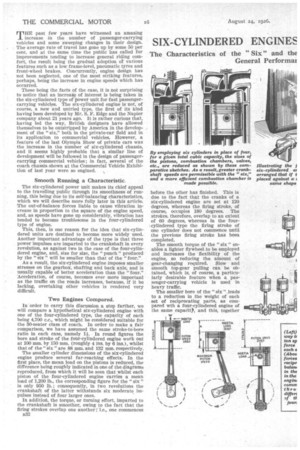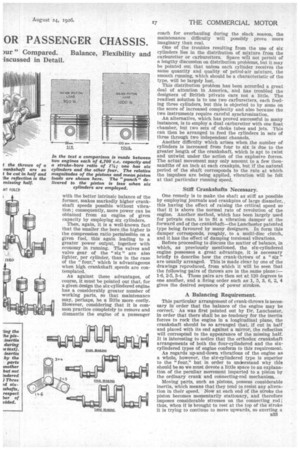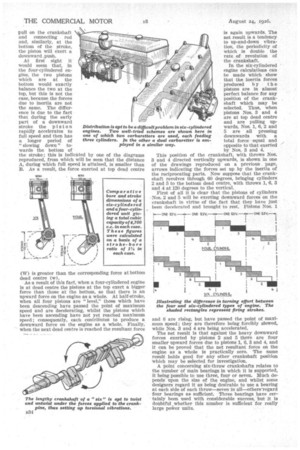SIX-CYLINDERED ENGINES OR PASSENGER CHASSIS.
Page 50

Page 51

Page 52

If you've noticed an error in this article please click here to report it so we can fix it.
The Characteristics of the " Six " and the General Performat )ur " Compared. Balance, Flexibility and iscussed in Detail.
T"past few years have witnessed an amazing increase in the number of passenger-carrying vehicles and some sweeping changes in their design. The average rate of travel has gone up by some 50 per cent, and at the same time the public has called for improvements tending to increase general riding comfort, the result being the gradual adoption °I various features such as a low frame-level, pneumatic tyres and front-wheel brakes. Concurrently, engine design has not been neglected, one of the most striking features, perhaps, being the increase in engine speeds which has occurred.
These being the facts of the ease, it is not surprising to notice that an increase of interest is being taken in the six-cylindered type of power unit for fast passengercarrying vehicles. The six-cylindered engine is not, of course, a new and untried type, the first of its kind having been developed by Mr. S. F. Edge and the Napier company about 21 years ago. It is rather curious that, having led the way, British designers have allowed themselves to be outstripped by America in the development of the "six," both in the private-ear field and in its application to commercial vehicles. However, a feature of the last Olympia Show of private ears was the increase in the number of six-cylinclered chassis, and it seems highly probable that a similar line of development will be followed in the design of passengercarrying commercial vehicles ; in fact, several of the coach chassis shown at the Commercial Vehicle Exhibition of last year were so engined.
Smooth Running a Characteristic.
The six-cylindered power unit makes its chief appeal to the travelling public through its smoothness of running, this being due to its self-balancing characteristics, which we will describe more fully later in this article. The out-of-balance forces liable to cause vibration increase in proportion to the square of the engine speed, and, as speeds have gone up considerably, vibration has tended to become troublesome in the four-cylindered type of engine.
This, then, is one reason for the idea that six-cylindered units are destined to become more widely used. Another important advantage of the type is that three power impulses are imparted to the crankshaft in every revolution, as against two in the case of the four-cylindered engine, and, size for size, the " punch " produced by the " six " will be smaller than that of the "four."
As a result, the six-cylincleral engine imposes smaller stresses on the gearbox, shafting and back axle, and is usually capable of better acceleration than the "four." Acceleration, of course, becomes ever more important as the traffic on the roads increases, beeause, if it be lacking, overtaking other vehicles is rendered very difficult.
Two Engines Compared.
In order to carry this discussion a step farther, we will compare a hypothetical six-cylindered engine with one of the four-cylindered type, the capacity of each being 4,700 c.c., which might be considered suitable for the 30-seater class of coach. In order to make a fair comparison, we have assumed the same stroke-to-bore ratio in each case, namely 11. In round figures the bore and stroke of the four-cylindered engine work Out at 100 mm. by 150 ram, (roughly 4 ins. by 6 ins.), whilst that of the "six " are 88 ram. and 132 mm. respectively.
The smaller cylinder dimensions of the six-cylindered engine produce several far-reaching effects. In the first place, the mean load on the pistons is reduced, the difference being roughly indicated in one of the diagrams reproduced, from which it will be seen that whilst each piston of the four-cylindered engine carries a mean load of 1,200 lb., the corresponding figure for the " six " is only 950 lb. ; consequently, in two revolutions the crankshaft of the latter withstands six moderate impulses instead of four larger ones.
In addition, the torque, or turning effort, imparted to the crankshaft is smoother, owing to the fact that the firing strokes overlap one another i.e., one commences B32
before the other has finished. This is due to the fact that the cranks of a six-cylindered engine are set at 120 degrees, Whereas the firing stroke, of course, occupies 180 degrees. The strokes, therefore, overlap to an extent of 60 degrees, whereas in the four. cylindered. type the firing stroke of one cylinder does not commence until the previous firing stroke has been completed.
The smooth torque of the " six " enables a lighter flywheel to be employed and increases the 'flexibility of the engine, so reducing the amount of gear-changing required. Slow and smooth top-gear pulling can be obtained, which is, of course, a particu larly desirable feature when a passenger-carrying vehicle is used in heavy traffic.
The smaller bore of the "six ".leads to a reduction in the weight of each
set of reciprocating parts, as compared wth a four-cylindered engine a the same capacity, and this, together
with the better intrinsic balance of the former, makes markedly higher crankshaft speeds possible without vibration; consequently, more power can be obtained from an engine of given capacity by employing six cylinders.
Then, again, it is a well-known fact that the smaller the bore Ithe higher is the compression ratio perinissible on a given fuel, this again leading to a greater power output, together with economy in running. The valves and valve gear of the " six " are also lighter, per cylinder, than in the case of the "four," which is advantageous when high crankshaft speeds are contemplated.
As against these advantages, of course, it must be pointed out that, for a given design the six-cylindered engine has a considerably greater number of working parts, so that maintenance may, perhaps, be a little more costly. However, considering that it is common practice completely to remove and dismantle the engine of a passenger coach for overhauling during the slack season, the maintenance difficulty will possibly prove more imaginary than real.
One of the troubles resulting from the use of six cylinders lies in the distribution of mixture from the carburetter or carburetters. Space will not permit of a lengthy discussion on distribution problems, but it may be pointed out that unless each cylinder receives the same quantity and quality of petrol-air mixture, the smooth running, which should be a characteristic of the type, will be largely lost.
This distribution problem has been accorded a great deal of attention in America, and has troubled the designers of British private cars not a little. The readiest solution is to use two carburetters, each feeding three cylinders, but this is objected to by some on the score of increased complexity and also because the two instruments require careful synchronization.
An alternative, which has proved successful in many instances, is to employ a dual carburetter with one float chamber, but two sets of choke tubes and jets. This can then be arranged to feed the cylinders in sets of three through two independent channels.
Another difficulty which arises when the number of cylinders is increased from four to six is due to the greater length of the crankshaft, which is apt to twist and untwist under the action of the explosive forces. The actual movement may only amount to a few thousandths of an inch at each crankpin, but if the natural period of the shaft corresponds to the rate at which the impulses are being applied, vibration will be felt at that particular running speed.
Stiff Crankshafts Necessary.
One remedy is to make the shaft as stiff as possible by employing journals and crankpins of large diameter, this having the effect of raising the critical speed so that it is above the normal rate of revolution of the engine. Another method, which has been largely used for private cars, is to fit a vibration damper at the forward end of the crankshaft—the Lanchester patented type being favoured by many designers. In form this damper corresponds, roughly, to a multi-disc clutch, and it has the effect of damping torsional vibrations.
Before proceeding to discuss the matter of balance, in which, as previously mentioned, the six-cylindered engine possesses a great advantage, it is necessary briefly to describe how the crank-throws of a are usually arranged. This is made clear by one of the drawings reproduced, from which it will be seen that the following pairs of throws are in the same plane:— 1-6, 2-5, 3-4. These pairs are then set at 120 degrees to one another, and a firing order such as 1, 5, 3, 6, 2, 4 gives the desired sequence of power strokes.
A Balancing Requirement.
This particular arrangement of crank-throws is neces sary in order that the balance of the engine may be correct. As was first pointed out by Dr. Lanchester, in order that there shall be no tendency for the inertia forces to rock the engine in a longitudinal plane, the crankshaft should be so arranged that, if cut in half and placed with its end against a mirror, the reflection will correspond to the appearance of the missing half.
It is interesting to notice that the orthodox crankshaft arrangements of both the four-cylindered and the sixcylindered types of engine conform to this requirement. As regards up-and-down vibrations of the engine as a whole, however, the six-cylindered type is superior to the "four," but in order to understand why this should be so we must devote a little space to an explanation of the peculiar movement imparted to a piston by the ordinary crank and connecting-rod mechanism.
Moving parts, such as pistons, possess considerable inertia, which means that they tend to resist any alteration in their speed. Now at each end of the stroke the piston becomes momentarily stationary, and therefore imposes considerable stresses on the connecting rod; thus, when it is brought to rest at the top of the stroke it is trying to continue to move upwards, so exerting a pull on the crankshaft and connecting rod and, similarly, at the bottom of the stroke, the piston will exert a downward ,push.
At first sight it would seem that, in the four-cylinclered engine, the two pistons which are at the bottom would exactly balance the two at the top, but this is not the case, because the forces due to inertia are not the same. The difference is due to the fact that during the early part of a downward stroke the piston rapidly accelerates to full speed and then has a longer period of " slowing down" towards the bottom of the stroke; this is indicated by one of the diagrams reproduced, from which will be seen that the distance A, during which full speed is attained, is smaller than B. As a result, the force exerted at top dead centre (W) is greater than the corresponding force at bottom dead centre (w).
As a result of this fact, when a four-cylindered engine is at dead centre the pistons at the top exert a bigger force than those at the bottom, so that there is an upward force on the engine as a whole. At half-stroke, when all four pistons are "level," those which have been descending have passed the point of maximum speed and are decelerating, whilst the pistons which have been ascending have not yet reached maximum speed ; consequently, each contributes to produce a downward force on the engine as a whole. Finally, when the next dead centre is reached the resultant force is again upwards. The net result is a tendency to up-and-down vibration, the periodicity of which is double the rate of revolution of the crankshaft.
In the six-cylindered engine calculations can be made which show that the inertia forces produced by the pistons are in almost perfect balance for any position of the crankshaft which may be selected. Thus, when pistons Nos. 3 and 4 are at top dead centre and are pulling upwards, Nos. 1, 6, 2 and 5 are all pressing downwards with a total force •equal and opposite to that exerted by Nos. 3 and 4.
This position of the crankshaft, with throws Nos. 3 and 4 directed vertically upwards, is shown in one of the drawings reproduced on a previous . page, arrows indicating the forces set up by the inertia of the reciprocating parts. Now suppose that the crankshaft revolves through 60 degrees, bringing cylinders 2 and 5 to the bottom dead centre, with throws 1,6, 3 and 4 at 120 degrees to the vertical.
First of all it is clear that the pistons of cylinders , Nos. 2 and 5 will be exerting downward forces on the crankshaft in virtue of the fact that they have just been decelerated and brought to rest. Pistons Nos. 1
and 6 are rising, but have passed the point of maximum speed; they are therefore being forcibly slowed, while Nos. 3 and 4 are being accelerated.
The net result is that against the heavy downward forces exerted by pistons 2 and 5 there are four smaller upward forces due to pistons 1, 6, 3 and 4, and it can be proved that the net resultant force on the engine as a whole is practically zero, The same result holds good for any other crankshaft position which may be selected for investigation.
A point concerning six-throw crankshafts relates to the number of main bearings in which it is supported, It being possible to use three, four or seven. Much depends upon the size of the engine, and whilst some designers regard it as being desirable to use a bearing at each side of each throw—seven in all—others-regard four bearings as sufficient. Three bearings have certainly been used with considerable success, but it is doubtful whether this number is sufficient for really large power units.




































































































